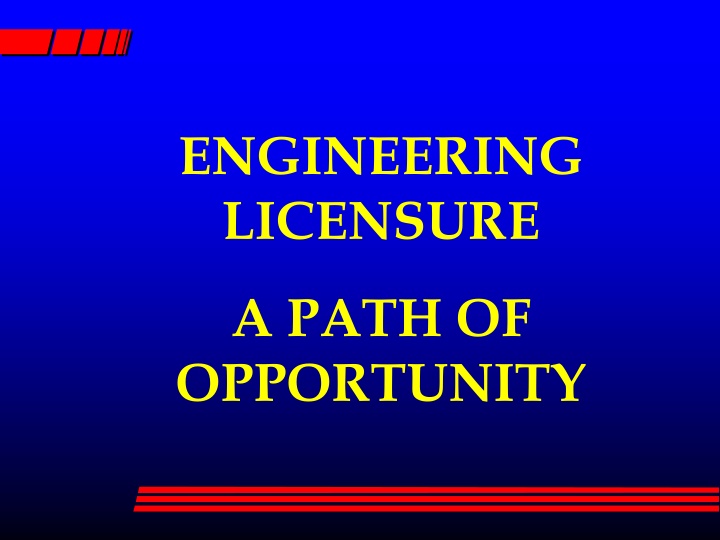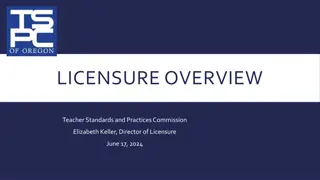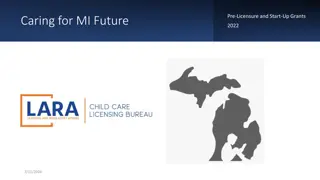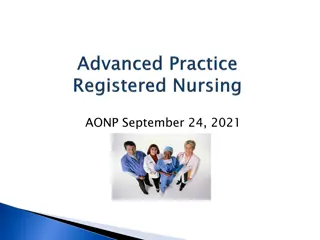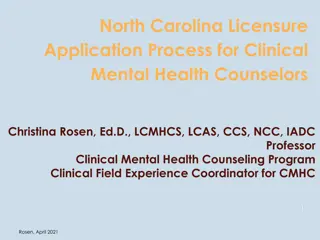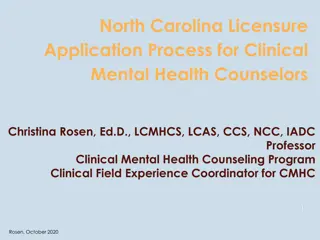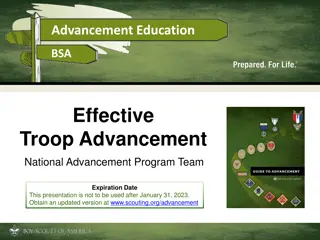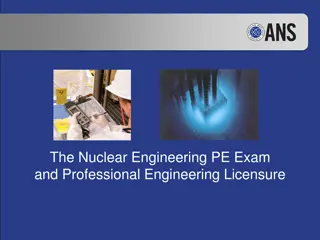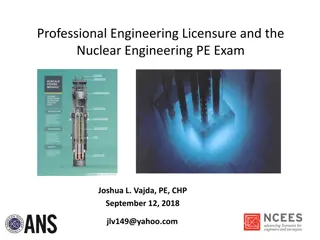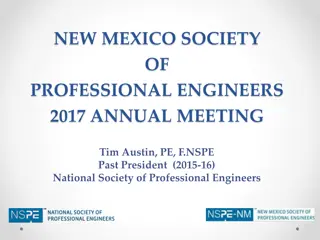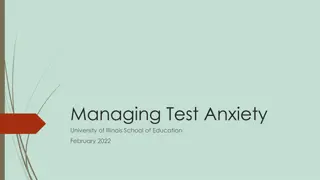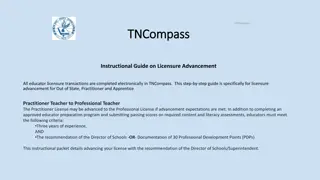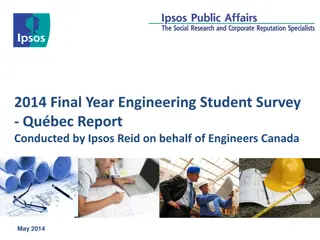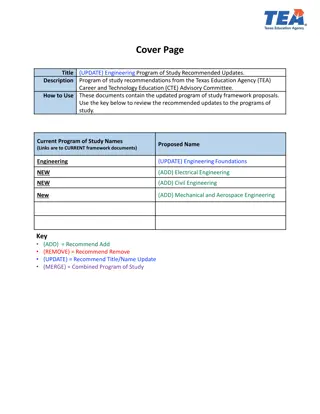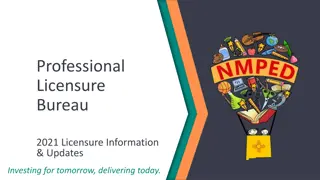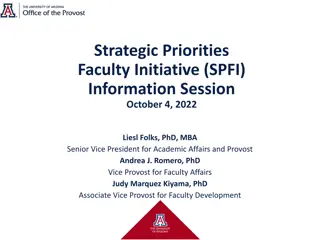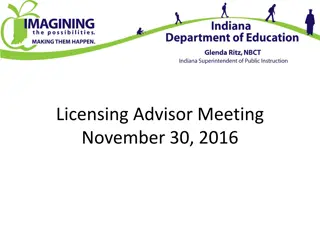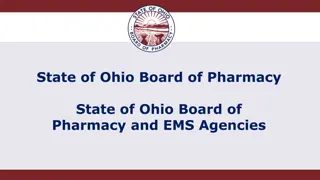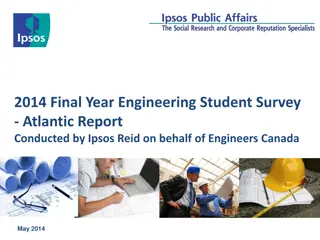Engineering Licensure: A Path to Professional Advancement
Explore the importance of engineering licensure for safeguarding public welfare and career development. Learn about the path to licensure, starting with the Fundamentals of Engineering (FE) exam, and discover the benefits of pursuing a Professional Engineer (PE) license. Find out why taking the FE exam can enhance your career prospects and earning potential, and how passing it opens up opportunities nationwide.
Download Presentation

Please find below an Image/Link to download the presentation.
The content on the website is provided AS IS for your information and personal use only. It may not be sold, licensed, or shared on other websites without obtaining consent from the author.If you encounter any issues during the download, it is possible that the publisher has removed the file from their server.
You are allowed to download the files provided on this website for personal or commercial use, subject to the condition that they are used lawfully. All files are the property of their respective owners.
The content on the website is provided AS IS for your information and personal use only. It may not be sold, licensed, or shared on other websites without obtaining consent from the author.
E N D
Presentation Transcript
ENGINEERING LICENSURE A PATH OF OPPORTUNITY
What is an engineer?? An engineer is an individual who uses his/her mathematical and engineering science skills to produce products and systems that are useful to mankind.
WHY DO WE HAVE LICENSURE? In order to safeguard life, health, and property, and to promote the public welfare.
Five Reasons to Get Licensed 1. Prestige 2. 3. Career Development Authority 4. Flexibility 5. Money
VIDEO VIDEO
Path to Licensure Pass the Fundamentals of Engineering (FE) examination Graduate from an ABET program with a degree in engineering Obtain 4 years of progressive engineering experience following the date of your degree Pass the Principles and Practice of Engineering (PE) examination
The path to licensure begins with the FE: the Fundamentals of Engineering Examination
Why take the FE Exam? To pursue PE license Professional Career Advancement More mobility More earning power More flexibility in career prospects YOU NEVER KNOW WHEN YOU WILL NEED IT.
Once you pass the FE, it is good forever and is accepted in all 50 states and numerous U.S. territories*.
FE EXAM You may take the exam anytime, but pass rates are the highest during your last two semesters in school .
2015 National FE Pass Rates Volume Exam Passs Rate Chemical Civil Electrical and Computer Environmental Industrial Mechanical Other Disciplines 1377 7873 1991 1023 353 5825 2121 76% 70% 75% 74% 64% 81% 80%
2015 National FE Pass Rates Pass Rates for those taking the Other Disciplines exam Exam Aeronautical/Aerospace Volume 61 69 141 219 71 64 202 311 59 51 Pass Rate 92% 90% 77% 88% 74% 83% 86% 72% 83% 88% Agricultural Architectural Biological Civil Engineering Physics General Engineering Petroleum Structural Systems
CBT In 2014, the FE Exam was converted to a computer based examination (CBT). The test is open year round. For tracking purposes, the test is divided into four windows: January - March April - June July - September October - December Sign up at NCEES.org
CBT There are 4 testing locations in Oklahoma Stillwater, Tulsa Norman and Oklahoma City However, you can take the examination at any Pearson Vue testing center in the nation. You will sign up with NCEES on a day and location that you choose.
CBT There are 7 different examinations Chemical Civil Electrical Environmental Industrial Mechanical Other Disciplines
CBT The CBT exam is 5 hours and 20 minutes long and will cover 110 questions. You will schedule a 6 hour block of time. This block will contain a tutorial, an optional 25 minute break, and an end of exam survey. The cost of the exam is $225.00.
CBT The CBT exam is a closed book exam but you will have an electronic reference manual available on a split screen. The reference material will be available for review or purchase on the NCEES website prior to the exam. Examinees will be able to bring and use NCEES approved calculators on CBT exams.
SCORES AND REEXAMINATION You will receive an email notification from NCEES. Results are usually available no more than 10 days after you take the exam (pass/fail). You may take the exam only one time per testing window and no more than three times in a 12 month period.
CBT Link to NCEES CBT Information. http://ncees.org/exams/fe-exam/
Engineer Intern After passing the FE exam and graduating you may apply to be certified as an engineer intern in any state or territory where you have accepted employment. In Oklahoma, EI Certification requires: 1. Passing the FE Exam 2. Graduating from an ABET degree program* 3. Character References from 3 people
Review: Steps to Licensure 1. Pass the FE Exam 2. Graduate from an ABET program with a degree in engineering 3. Obtain 4 years of progressive engineering experience following the date of your degree 4. Pass the P.E. Exam Once you pass the FE, it is good forever and the pass rate is much higher for those who take the exam while still in school.
Principles and Practice of Engineering Examinations Mechanical (3 modules) Metallurgical Mining and Mineral Naval Architecture & Marine Engineering Nuclear Petroleum Software Structural (16 hr. exam) Agricultural Architectural Chemical Civil (5 modules) Control Systems Electrical & Computer (3 Choices of Exams) Environmental Fire Protection Industrial
Questions? Connect With Us oklahomapels @OklahomaPELS
